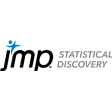An upcoming JMP webinar will show how data-driven decision-making can improve predictability and boost efficiency
Researchers, developers and engineers may question whether they have the capacity to adopt data analytics into their busy working lives. When there is always more to achieve than there are hours in the day, how is it possible to become an expert in data analytics as well?
Colleagues and management teams do not always see the benefits of data-driven decision-making either, happily entrenched in traditional approaches to decision-making based on a combination of subject matter knowledge, anecdotal evidence and experimentation. The resistance to change can be overwhelming.
Data analytics cuts the time required for R&D, helping the team support twice as many products
For those who have worked through the challenges and overcome the initial hurdles, however, the results can be transformational. With the right data analytics tools geared to the way scientists and engineers think about their data, tasks that previously took days, weeks or even months can be reduced to minutes and hours. The benefits include greater predictability, improved efficiency and the freedom to focus on the next challenge. It is enough to make proponents of data analytics passionate about the possibilities.
Looking at the data
Julia O’Neill has more than 30 years’ experience using statistics and chemical engineering to solve problems in chemistry, vaccines, biologics and pharma. She has seen how supplementing subject matter knowledge with data analytics can help change an organisation’s approach. Data analytics can cut through the noise and challenge the preconceived ideas of those close to the process. It can bring about a breakthrough when there is a lack of consensus and the team is running out of ideas to overcome a specific problem.
Investigating a root cause for an issue with yield in a vaccine manufacturing process, O’Neill says the problem had been ongoing for some time and that analytics was almost the last resort for finding a solution. The various teams involved all had theories, she explains. The downstream scientists were convinced the problem was in the chromatography steps and the upstream scientists thought a raw material change was the culprit. The lab people didn’t think it was their fault because they had made some improvements to analytical testing at around the same time. The operators running the process had noticed some changes, but no one was listening to them. The organisation had reached an impasse.
Sometimes, it is a single compelling graph or interactive visualisation of a problem that generates consensus
The decision was made to gather the data and put it into electronic format, then begin to apply analytics to uncover the best way forward. By looking at the data and acting on what it revealed, rather than searching for evidence to support existing theories, the organisation achieved a breakthrough. O’Neill describes how the early results of the analysis changed everything. ‘The whole investigation turned at that moment. The data helped us all to focus. Analytics allowed us to build consensus and to start listening to the process technicians and what they had been trying to tell us all along,’ she says. In this kind of situation, it is often those who shout loudest who get heard. Data analytics can help to level the playing field and allow members of the team to relinquish erroneous beliefs that may be holding the whole operation back. By trusting the data and allowing analytics to act as a myth killer, greater advances come within reach.
Demonstrating success
Solving a high-profile problem for your organisation will certainly raise the profile of an analytics approach. O’Neill urges people to take risks and tackle the big problems with data analytics, rather than the projects that allow you to hide. High-profile projects are more likely to get resourcing and management attention, which in turn help to drive momentum and organisational change when people start to see the results.
With data analytics capabilities in the hands of the subject matter experts, organisations can scale more rapidly

In O’Neill’s vaccine manufacturing example, the problem with yield had been ongoing for two years and was solved in three weeks once the data was available. There are many other examples of massive reductions in total development time – the total time it takes to reach a stated goal – achieved through data analytics. The scale of change may be dramatic.
The resulting freedom to innovate, to move on to solving other problems, to adopt proactive approaches rather than reactive, can make all the difference to the motivation levels of the teams involved. O’Neill describes how data analytics ‘can cut the time required for R&D, helping the team support twice as many products and bring them to market twice as fast. And because knowledge accumulates, researchers can innovate more predictably over time.’
Building momentum
The clarity and certainty of data-driven decision-making can transform the outlook of a team and help to drive a problem-solving culture based on analytics excellence. There may be an initial investment of time required to plan the approach, but if data is available in electronic format it can be used and analysed effectively. It is only by starting to ask questions of your data that you can understand whether you have the right data in the first place.
In the online webinar Bridging statistics and chemical engineering for biotech and pharma O’Neill says ‘one of the things that holds people back is they feel like they have to get it perfect before they can start. I’d say, dive in and try it. You can start fairly small and simple … Because you have to put in the up-front planning, people perceive it as being more work and more effort. But in the end, it saves so much time.’
She also advises not to use lack of data availability as an excuse. The results can quickly convince colleagues, teams and the wider organisation that there are significant time savings and cost reductions to be achieved if they embrace new techniques. Sometimes it can be the production of a single compelling graph, or an interactive visualisation of the problem, that helps generate consensus. Data analytics can help to focus the team and deliver the certainty and predictability to reassure the wider organisation. It can also reduce the stress levels of the individuals involved, leading to a more productive, fulfilled team able to reach its potential.
Achieving scale
Delivering results and solving high-profile problems can rapidly generate interest from the wider organisation. Management and leadership teams will want to understand how to capture the value of a data analytics approach once they start to see its positive impact. Scaling data analytics to help transform an organisation requires the right tools. Selecting a tool that guides non-statisticians through appropriate ways of analysing their data helps to ensure the willing adoption of new ways of working. Indeed, O’Neill has found that in a head-to-head comparison, a tool designed around the way scientists and engineers think about data in the first place is a winning choice. Avoiding a silo mentality is also crucial. By enabling researchers and developers to conduct their own analysis, organisations can scale from the ground up. By putting data analytics capabilities into the hands of the subject matter experts – those who understand the data, its origins and its quality – organisations can scale capabilities more rapidly to meet the growing demand for analytics excellence.
Join us to hear more from Julia O’Neill and her experiences delivering results through data analytics.
Register for the upcoming webinar Accelerating commercialisation of therapies for unmet medical needs
The webinar will take place at 1pm UK time on 5 May 2020.


















No comments yet